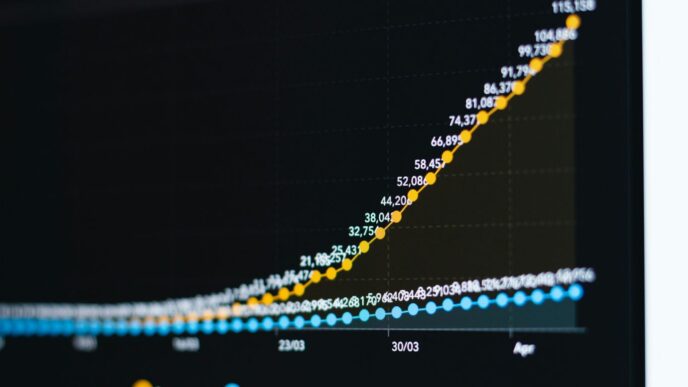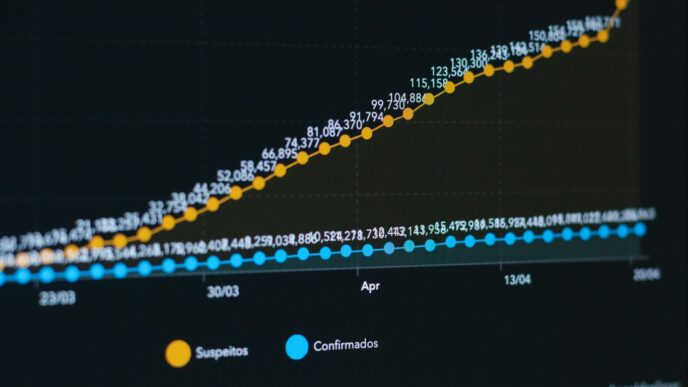So, you’ve probably seen the ticker symbol ‘CMI’ floating around, and maybe you’re wondering what it’s all about. It’s easy to get confused because ‘CMI’ can mean a few different things, but most often, it points to Cummins Inc., a big name in the engine and power solutions world. But the story of CMI goes beyond just stock prices. It’s about their actual business, how they’re trying to be more eco-friendly, and what they’re cooking up for the future. Let’s break it down.
Key Takeaways
- Cummins Inc., known by its stock ticker CMI, is a global leader in power solutions, offering a wide range of products from traditional engines to advanced electrified and hydrogen-based systems.
- The company is actively working towards sustainability goals with its ‘Destination Zero’ strategy, aiming to reduce emissions across its product lifecycle and operations.
- CMI is investing heavily in future technologies, including electrified powertrains and hydrogen fuel cells, through internal development and strategic partnerships.
- Financial performance shows steady sales and profitability, with recent reports indicating strong net income and strategic moves like the divestiture of Atmus Filtration Technologies.
- Cummins is focused on adapting to market changes, anticipating future demand, and continuing to return value to shareholders through dividends and stock management.
Understanding Cummins Stock (CMI)
When you see ‘CMI’, it most often refers to Cummins Inc., a company that’s been around for a long time, since 1919 actually. They started out making diesel engines and have grown into a big player in power solutions. Think of them as a company that provides the engines and related parts for all sorts of heavy-duty stuff, from trucks and construction equipment to power generators. They’ve got a pretty wide reach, operating globally with a bunch of different business segments.
Cummins Inc. Overview
Cummins Inc. is a global leader in power solutions. They’re not just about diesel engines anymore; their business now covers a lot more ground. They have five main segments: Components, Engine, Distribution, Power Systems, and Accelera by Cummins. This means they’re involved in everything from the nuts and bolts of engines to complete power systems, including electric and hybrid options. They also have a big focus on sustainability and helping customers move towards cleaner energy. It’s a pretty complex operation with a huge network of manufacturing, service, and support.
Financial Performance and Reporting
Looking at Cummins’ financial reports can give you a good idea of how the company is doing. They report their sales and profits regularly. For example, in the first half of 2024, they reported net sales of around $17.2 billion. Their net income attributable to Cummins Inc. for the same period was about $2.7 billion. It’s helpful to see how these numbers change over time to understand trends. They also report on things like operating income and earnings per share, which are key figures for investors.
Here’s a quick look at some recent figures:
| Period | Net Sales (in millions) | Net Income Attributable to Cummins Inc. (in millions) | Diluted Earnings Per Share |
|---|---|---|---|
| Six months ended June 30, 2024 | $17,199 | $2,719 | $19.42 |
| Six months ended June 30, 2023 | $17,091 | $1,510 | $10.60 |
Stock Performance and Shareholder Returns
As a publicly traded company, Cummins’ stock is available on the New York Stock Exchange under the ticker symbol CMI. Tracking its stock performance is how many people interact with the company as investors. Like any stock, CMI’s price can go up and down based on market conditions, company news, and overall economic factors. Cummins also has a history of returning value to shareholders through dividends. For instance, they’ve paid out dividends per share, which is a way they share profits directly with their owners. Keeping an eye on these aspects can tell you a lot about investor confidence and the company’s financial health from a market perspective.
Cummins’ Diverse Business Segments
Cummins isn’t just about one thing; they’ve got a whole range of operations going on. Think of it like a big toolbox, with different tools for different jobs. They’re organized into five main segments, and each one plays a part in powering the world.
Engine and Components Divisions
This is probably what most people think of when they hear ‘Cummins’. They make engines, of course, for all sorts of vehicles and equipment – trucks, buses, construction gear, you name it. But it’s not just the big engines. They also produce a ton of related parts, like turbochargers, fuel systems, and all the bits and pieces that make an engine run smoothly. It’s a huge part of their business, and they’ve been doing it for a long time.
Distribution and Power Systems
Beyond just making the engines and parts, Cummins also handles getting them out there and making sure they work. The Distribution segment is all about their network of distributors and dealers, which is pretty massive, reaching almost every corner of the globe. They also have a Power Systems division. This part focuses on things like power generation – think backup generators for hospitals or data centers, and even systems for marine applications. It’s about providing reliable power, no matter the situation.
Accelera by Cummins and Future Technologies
This is where things get really interesting, especially with the push towards cleaner energy. Accelera is Cummins’ brand focused on new power solutions. They’re heavily involved in electrified powertrains, hybrid systems, and even cutting-edge stuff like hydrogen fuel cells and battery technologies. It shows they’re not just sticking to what they know but are actively investing in the future of power. They’ve even formed a joint venture, Amplify Cell Technologies, to help build out the battery supply chain right here in the U.S. It’s a big move to support the shift to zero-emission vehicles and equipment.
CMI’s Commitment to Sustainability

Cummins isn’t just about building powerful engines; they’re also really focused on making things better for the planet. This commitment is a big part of their whole operation. They call it their ‘Destination Zero’ strategy, and it’s all about cutting down on emissions and helping their customers do the same. It’s not just talk, either. They’ve got a whole plan laid out.
Destination Zero Strategy
So, what exactly is ‘Destination Zero’? It’s basically Cummins’ roadmap to a future with zero emissions. They’re aiming to reduce greenhouse gas emissions from their products and operations. This involves a few key areas:
- Reducing emissions from new products: This means developing cleaner engines and powertrains that use less fuel and produce fewer harmful gases.
- Reducing operational emissions: They’re looking at their own factories and facilities to cut down on energy use and waste.
- Supporting customers in their transition: Cummins wants to help businesses switch to more sustainable power sources, offering a range of options.
Environmental Responsibility and Emissions Reduction
When you look at Cummins, you see a company that’s actively working to be kinder to the environment. They’ve been involved in some regulatory discussions, like settling with the EPA and other groups about emissions certification. While that sounds complicated, the main point is they’re taking responsibility and making changes. They’re investing in technologies that help reduce pollutants, not just from their engines but also from their manufacturing processes. It’s a pretty big undertaking, considering how many products they make and where they operate.
Sustainability Ratings and Recognition
Companies that do well in sustainability often get noticed. While specific ratings can change, Cummins has generally been recognized for its efforts. They report on their progress, showing how they’re doing against their goals. This transparency is important because it lets investors and customers see that they’re serious about their environmental promises. It’s not always easy, and there are always new challenges, but the focus on sustainability is clearly a core part of how Cummins sees its future.
Innovation in Powertrain Technology
Cummins isn’t just about building engines anymore; they’re really pushing the envelope on what powers our world. They’ve got a whole range of stuff going on, from the tried-and-true diesel and natural gas engines to some pretty cutting-edge electric and hydrogen tech. It’s clear they’re thinking about the future, and not just for trucks, but for all sorts of heavy-duty applications.
Advanced Diesel and Natural Gas Engines
While the spotlight often shines on new technologies, Cummins is still a major player in advanced diesel and natural gas engines. They’ve been refining these for decades, and the latest versions are more efficient and cleaner than ever. Think about it – these engines are the backbone of so many industries, from construction to agriculture. Cummins is focused on making them perform better while also reducing their environmental footprint. They’re not just slapping on a new label; they’re engineering improvements into the core technology.
Electrified and Hybrid Powertrains
This is where things get really interesting. Cummins is investing heavily in electrified and hybrid powertrains. They’re developing battery systems and electric drive components that can be integrated into various vehicles and equipment. This isn’t just a side project; it’s a significant part of their strategy to offer zero-emission solutions. They’re working on making these systems robust enough for tough commercial use, which is a whole different ballgame than passenger cars.
Hydrogen and Fuel Cell Solutions
Looking even further ahead, Cummins is diving into hydrogen technology, specifically fuel cells. They see hydrogen as a key fuel for the future, especially for long-haul transportation and heavy-duty applications where battery-electric might have limitations. They’re developing electrolyzers to produce hydrogen and fuel cell systems that convert hydrogen into electricity. This move into hydrogen positions Cummins as a leader in a potentially massive future market. It’s a complex area, but they’re building on their existing expertise in power generation and engine management to tackle it.
Strategic Partnerships and Joint Ventures

Cummins isn’t just building engines and power systems on its own; they’re also teaming up with other big players to get ahead. It’s like they know that sometimes, working together is the smartest way to tackle big projects, especially when it comes to new tech.
Collaboration with Isuzu Motors
Cummins has a long-standing relationship with Isuzu Motors, a Japanese company known for its trucks and diesel engines. This partnership is all about making sure they can offer the best diesel engines for medium-duty trucks in various markets. They’ve set up joint ventures in places like China and North America to build and sell these engines. This collaboration helps both companies share costs and expertise, making them more competitive. It’s a smart move to cover more ground and meet customer needs efficiently.
Amplify Cell Technologies Joint Venture
This is a pretty big deal, especially with the shift towards electric vehicles. Cummins, through its Accelera business, has joined forces with Daimler Truck, PACCAR, and EVE Energy to create Amplify Cell Technologies. The main goal here is to get battery cell production ramped up and establish a solid battery supply chain right here in the U.S. They’re even planning a big battery production plant in Mississippi. This venture is designed to make battery cells for electric trucks and other industrial uses. It’s a significant investment, with Cummins committing a substantial amount of capital over the next few years, though some of that could be offset by government help. The plan is for this facility to start producing batteries around 2027.
Impact on Battery Production and Supply Chain
Forming Amplify Cell Technologies is a clear signal that Cummins is serious about the future of electric power. By partnering with other industry leaders, they’re not just investing in battery production; they’re also helping to build out the whole system needed to support electric vehicles. This includes making sure there are enough batteries and that the supply chain is reliable. It’s a complex undertaking, but these kinds of partnerships are what will help drive the adoption of new technologies across the board. It shows they’re thinking ahead and trying to secure their place in the evolving energy landscape.
Navigating Market Dynamics
Okay, so thinking about how Cummins fits into the bigger picture, it’s not just about their engines or batteries. There’s a whole lot of stuff happening in the world that can really shake things up for them. It’s like trying to drive a truck through a busy city – you’ve got to watch out for all sorts of things.
Anticipated Market Demand
This is a big one. What are people going to need in the future? Are more companies going to want cleaner engines, or will electric power take over completely? Cummins has to guess, and then build enough stuff to meet that demand. If they guess wrong, they could end up with too much inventory or not enough to sell. They’re constantly trying to figure out what the world will want next, from heavy-duty trucks to power generators. It’s a tricky balancing act, for sure.
Profitability and Cash Flow Projections
Making money is obviously important. Companies like Cummins need to make sure they’re not just selling things, but that they’re selling them at a price that covers their costs and then some. This means looking at how much it costs to get the parts, how much it costs to pay their workers, and what they can actually charge customers. They also need to have enough cash coming in to pay their bills and invest in new projects. It’s all about making sure the money keeps flowing in the right direction.
Investment in Future Growth
To stay ahead, Cummins can’t just keep doing what they’ve always done. They have to put money into new ideas and new technologies. This could mean spending a lot on research for things like hydrogen fuel cells or improving their electric motor designs. It’s a gamble, really. They’re betting that these new things will be what customers want and need down the road. It’s how they plan to keep growing and not get left behind by competitors or changing times. They’ve got to keep an eye on a few key areas:
- New Technology Development: Pouring money into R&D for things like advanced battery tech and hydrogen power.
- Manufacturing Capacity: Making sure they can actually build enough of these new products if demand takes off.
- Acquisitions and Partnerships: Sometimes it’s faster to buy a company with new tech or team up with others to share the costs and risks of developing something big.
Wrapping It Up: More Than Just a Stock Ticker
So, we’ve seen that ‘CMI’ can mean a few different things. Most often, it’s about Cummins Inc., a big player in power solutions, from diesel engines to newer electric tech. They’re focused on sustainability and adapting to new energy trends, which is pretty interesting. But ‘CMI’ can also pop up in other contexts, like content marketing initiatives or project management. The key takeaway is that while the stock symbol might be the most common association, understanding the broader meaning of CMI depends on where you see it. It’s a good reminder that acronyms can have multiple lives, and context is everything. Whether you’re looking at financial reports or planning your next marketing campaign, knowing what CMI refers to helps keep things clear.
Frequently Asked Questions
What is Cummins Inc. and what do they make?
Cummins Inc. is a big company that makes engines and other power stuff. They create engines for trucks, buses, and even big machines. They also make parts for these engines, like turbochargers and fuel systems. Plus, they’re getting into newer technologies like electric and hydrogen power.
What does ‘CMI’ mean when talking about Cummins?
CMI is the stock ticker symbol for Cummins Inc. on the stock market. When people talk about ‘CMI stock,’ they’re referring to shares of ownership in the Cummins company.
How is Cummins doing financially?
Cummins generally does well financially. They report their sales and profits regularly. While specific numbers change, they’ve had billions in sales and have been working to improve their profits and manage their money wisely.
What is Cummins’ ‘Destination Zero’ strategy?
Destination Zero is Cummins’ plan to be more environmentally friendly. It’s all about reducing pollution and emissions from their products. They want to help their customers use cleaner energy sources and move towards a future with zero harmful emissions.
Is Cummins investing in new types of engines?
Yes, absolutely! Besides their traditional diesel and natural gas engines, Cummins is heavily investing in electric and hybrid powertrains. They are also exploring hydrogen fuel cell technology and working on ways to produce hydrogen.
Does Cummins work with other companies?
Yes, Cummins often partners with other companies. For example, they have teamed up with Isuzu Motors to create new engines. They also have joint ventures, like Amplify Cell Technologies, to help build batteries for electric vehicles, showing they are working with others to shape the future of power.














